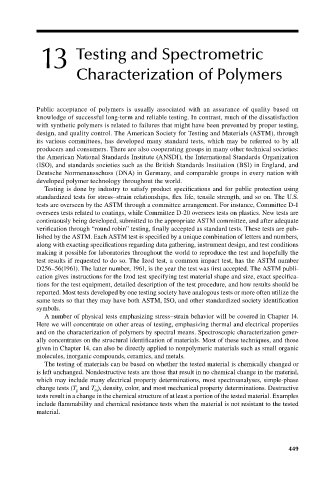Page 486 - Carrahers_Polymer_Chemistry,_Eighth_Edition
P. 486
13 Testing and Spectrometric
Characterization of Polymers
Public acceptance of polymers is usually associated with an assurance of quality based on
knowledge of successful long-term and reliable testing. In contrast, much of the dissatisfaction
with synthetic polymers is related to failures that might have been prevented by proper testing,
design, and quality control. The American Society for Testing and Materials (ASTM), through
its various committees, has developed many standard tests, which may be referred to by all
producers and consumers. There are also cooperating groups in many other technical societies:
the American National Standards Institute (ANSDI), the International Standards Organization
(ISO), and standards societies such as the British Standards Institution (BSI) in England, and
Deutsche Normenausschuss (DNA) in Germany, and comparable groups in every nation with
developed polymer technology throughout the world.
Testing is done by industry to satisfy product specifications and for public protection using
standardized tests for stress–strain relationships, flex life, tensile strength, and so on. The U.S.
tests are overseen by the ASTM through a committee arrangement. For instance, Committee D-1
oversees tests related to coatings, while Committee D-20 oversees tests on plastics. New tests are
continuously being developed, submitted to the appropriate ASTM committee, and after adequate
verification through “round robin” testing, finally accepted as standard tests. These tests are pub-
lished by the ASTM. Each ASTM test is specified by a unique combination of letters and numbers,
along with exacting specifications regarding data gathering, instrument design, and test conditions
making it possible for laboratories throughout the world to reproduce the test and hopefully the
test results if requested to do so. The Izod test, a common impact test, has the ASTM number
D256–56(1961). The latter number, 1961, is the year the test was first accepted. The ASTM publi-
cation gives instructions for the Izod test specifying test material shape and size, exact specifi ca-
tions for the test equipment, detailed description of the test procedure, and how results should be
reported. Most tests developed by one testing society have analogous tests or more often utilize the
same tests so that they may have both ASTM, ISO, and other standardized society identifi cation
symbols.
A number of physical tests emphasizing stress–strain behavior will be covered in Chapter 14.
Here we will concentrate on other areas of testing, emphasizing thermal and electrical properties
and on the characterization of polymers by spectral means. Spectroscopic characterization gener-
ally concentrates on the structural identification of materials. Most of these techniques, and those
given in Chapter 14, can also be directly applied to nonpolymeric materials such as small organic
molecules, inorganic compounds, ceramics, and metals.
The testing of materials can be based on whether the tested material is chemically changed or
is left unchanged. Nondestructive tests are those that result in no chemical change in the material,
which may include many electrical property determinations, most spectroanalyses, simple-phase
change tests (T and T ), density, color, and most mechanical property determinations. Destructive
m
g
tests result in a change in the chemical structure of at least a portion of the tested material. Examples
include flammability and chemical resistance tests when the material is not resistant to the tested
material.
449
9/14/2010 3:42:13 PM
K10478.indb 449
K10478.indb 449 9/14/2010 3:42:13 PM

